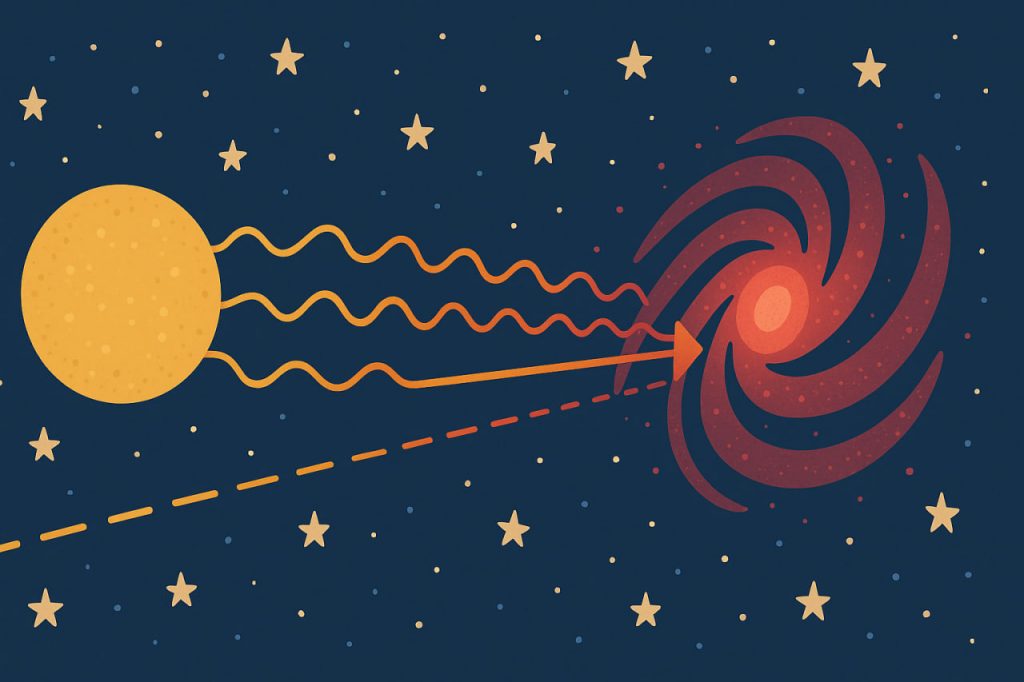Redshift is a key concept in astronomy that helps scientists understand how distant celestial objects move in space. When we observe light from stars and galaxies, we’re not just seeing brightness — we’re also reading information embedded in that light. One of the most important clues comes from shifts in the wavelengths of that light. A redshift means the light has stretched, shifting toward the red end of the visible spectrum. This stretching tells us that the object emitting the light is moving away from us. Redshift has become a cornerstone for discovering that the universe is expanding.
The Science Behind Redshift
Light travels in waves, and these waves have measurable lengths. When an object moves toward us, the wavelengths get compressed — this is called blueshift. When an object moves away, the wavelengths stretch out — resulting in redshift.
This effect is similar to the Doppler effect, which we experience with sound: a siren sounds higher as it approaches and lower as it moves away. With light, redshift is the visual equivalent, but on a cosmic scale.
Astronomers detect redshift by analyzing spectral lines — unique fingerprints left by elements in stars and galaxies. When these lines are shifted toward the red end of the spectrum, it indicates redshift and motion away from the observer.
Types of Redshift
There are three primary types of redshift:
- Doppler Redshift: Caused by the motion of a star or galaxy away from us.
- Cosmological Redshift: Caused by the expansion of space itself, stretching light over billions of years.
- Gravitational Redshift: Caused by light escaping strong gravitational fields, such as near black holes, which stretches the light as it climbs away from the gravity source.
Each type gives different insights about the object’s speed, distance, or the nature of the surrounding space.
Redshift and the Expanding Universe
In 1929, astronomer Edwin Hubble discovered that most galaxies exhibit redshift, and the farther they are from us, the greater the redshift. This led to the conclusion that the universe is expanding, and the galaxies are moving away from each other.
This discovery became the foundation of the Big Bang theory — the idea that the universe began from an extremely dense and hot state and has been expanding ever since. By measuring redshift, astronomers can estimate how fast the universe is expanding and how old it is.
Measuring Distance and Time Using Redshift
Redshift is often expressed as a value known as z. The higher the z-value, the farther away and older the object is. Some galaxies and quasars have redshifts so high that their light began its journey billions of years ago, giving us a glimpse into the early universe.
Redshift is not just a measure of speed — it’s a tool for building a cosmic timeline, helping scientists understand how galaxies, stars, and black holes evolved over time.
Limitations and Challenges
While redshift is powerful, it comes with challenges. Distant objects are faint, and their light can be affected by intervening matter or gravitational lensing. Precise measurements require powerful telescopes and accurate models. Moreover, distinguishing between redshift caused by motion and redshift caused by space expansion isn’t always simple, especially at extreme distances.
Still, redshift remains one of the most valuable tools in observational cosmology.
Glossary
- Redshift: A shift of light toward longer wavelengths, indicating that an object is moving away.
- Doppler effect: The change in frequency or wavelength of a wave in relation to an observer.
- Spectral lines: Unique patterns in light caused by the absorption or emission of specific elements.
- Cosmological redshift: Redshift caused by the expansion of the universe.
- Gravitational redshift: Redshift caused by light escaping from a strong gravitational field.
- Blueshift: A shift of light toward shorter wavelengths, indicating an object is moving closer.
- Big Bang: The scientific theory that the universe originated from a single point and has been expanding ever since.
- z-value: A numerical value expressing the amount of redshift observed in a distant object.


